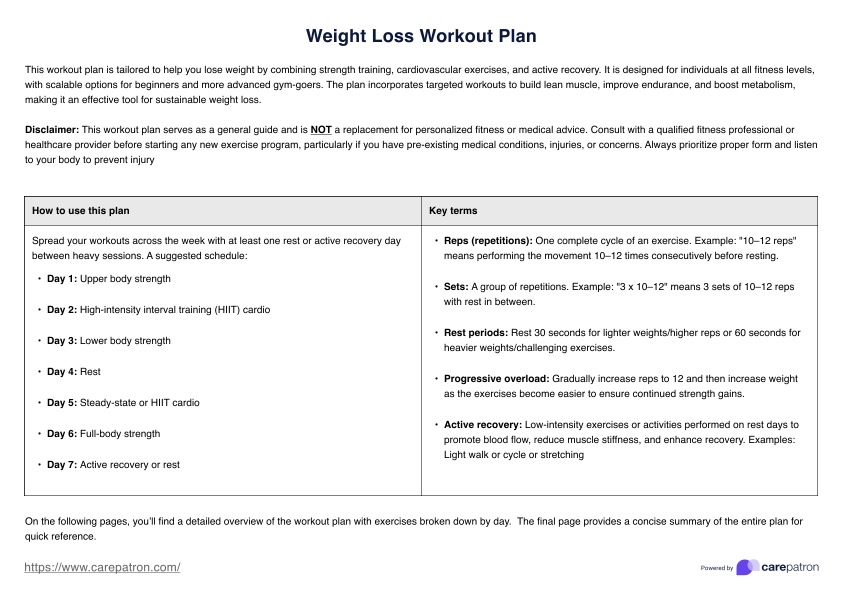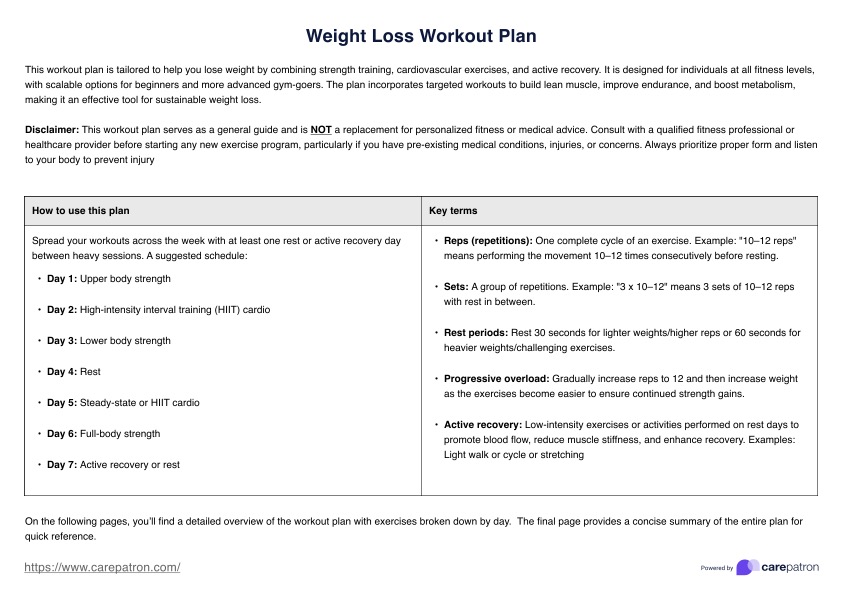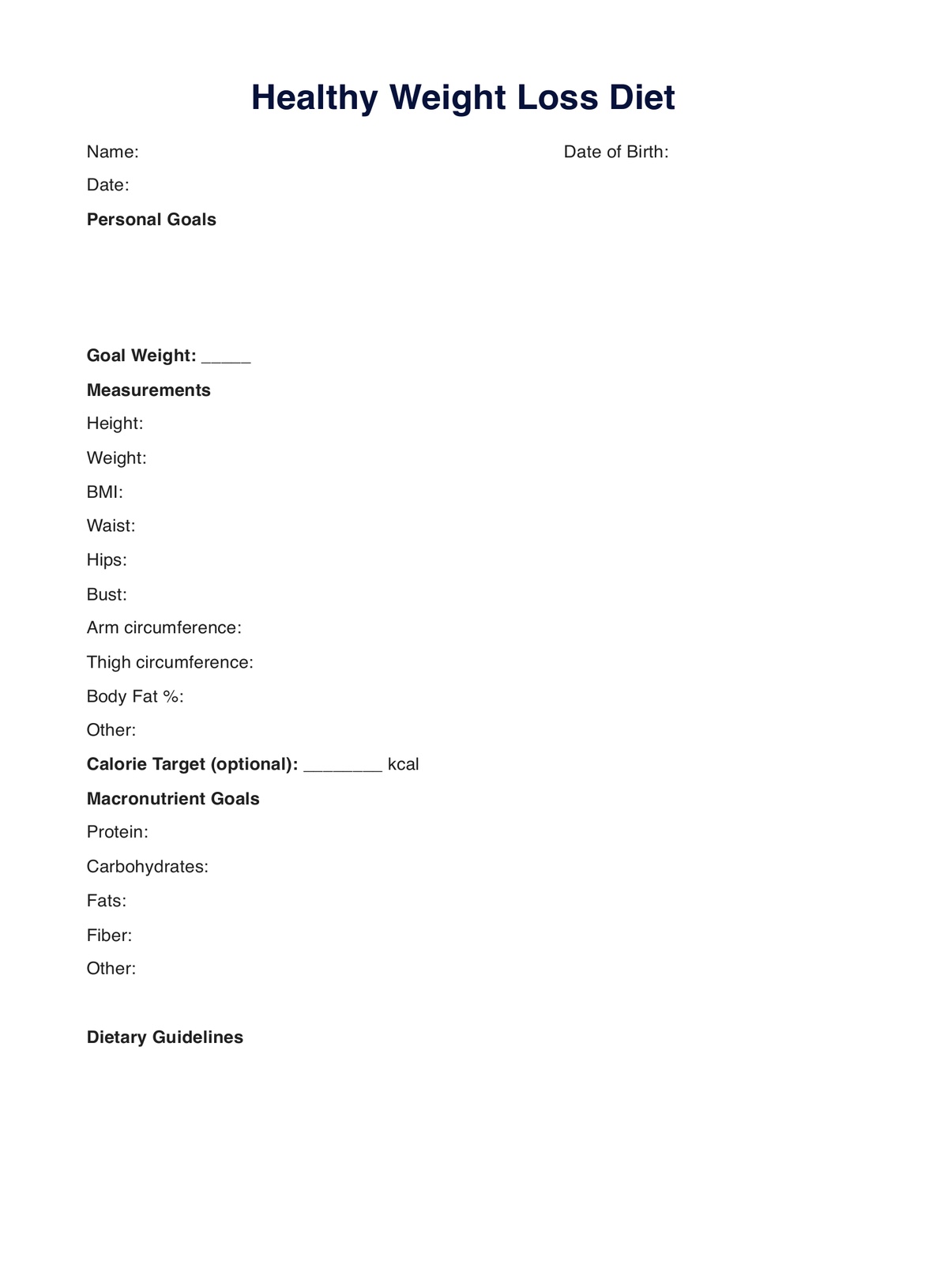Weight Loss Workout Plan
Access our Weight Loss Workout Plan to support your clients' weight loss journeys with structured workouts, balanced cardio, and strength training for lasting results.


What is our Weight Loss Workout Plan template?
The Weight Loss Workout Plan is a structured and customizable framework designed to help clients achieve sustainable fat loss, improve overall fitness, and enhance their health. This template integrates a balance of strength training, cardiovascular workouts, and active recovery, ensuring a comprehensive approach to weight management. It provides clear guidance, helping clients maintain consistency, motivation, and focus on their goals.
The template follows a five-day exercise schedule incorporating strength training sessions, high-intensity interval training (HIIT), steady-state cardio, and active recovery days. It offers flexibility in activity selection to suit individual preferences, fitness levels, and equipment availability. Strength training focuses on preserving lean muscle mass, a key component for boosting metabolism and supporting long-term fat loss. Exercises are designed with progressive overload principles to encourage continuous improvement and adapt to the client's progress.
Weight Loss Workout Plan Template
Weight Loss Workout Plan Example
How to use our Weight Loss Workout Plan?
Follow These Steps to Effectively Integrate the Weight Loss Workout Plan into your practice:
Step 1: Access and personalize the plan
The workout plan is available as a customizable template within this guide. To get started, click “Use template” to open it in the Carepatron app, where you can tailor it to your client’s specific needs and fitness goals. For clients who prefer a physical copy, a fillable PDF version is also available under the "Download" option. Ensure you adapt the plan to align with their fitness level, preferences, and access to equipment.
Step 2: Introduce the plan to your client
During your session, explain the structure, purpose, and unique aspects of the workout plan. Highlight how it is designed to build foundational strength, improve muscle tone, and boost metabolism. Emphasize that while the workouts contribute significantly to toning and fitness, fat loss requires a calorie deficit, achieved by consuming fewer calories than their body burns. Discuss how regular exercise complements mindful eating to create sustainable weight loss.
Step 3: Demonstrate exercises and ensure proper form
Walk your client through each exercise in the plan, demonstrating proper form and technique. Focus on ensuring safety and effectiveness to prevent injuries and maximize results. Address any questions or concerns about specific movements or equipment. For clients new to fitness or the gym environment, confidently provide detailed guidance on using machines and weights. Reinforce the importance of controlled, intentional movements and adjusting intensity based on their ability.
Step 4: Provide ongoing support and adjustments
Regularly check in with your client to assess their progress, energy levels, and any challenges they encounter. Monitor their performance during sessions and adapt the plan to maintain effectiveness. Adjust exercises, intensity, or volume to suit their evolving capabilities and goals. Celebrate milestones, such as strength gains, improved endurance, or changes in body composition, to keep them motivated and engaged.
Step 5: Encourage rest, recovery, and nutrition
Educate your client on the importance of rest and active recovery for muscle repair and overall well-being. Suggest light activities such as walking, yoga, or stretching for recovery days to keep their body moving without overexertion. Reinforce the role of proper hydration, balanced nutrition, and sufficient sleep in supporting their fitness and fat loss journey. Remind them that maintaining a calorie deficit is essential for fat loss and that combining it with consistent workouts will produce the best results.
Step 6: Store client information securely
Maintain detailed records of your client’s workout plans, progress, and adjustments made over time. Use secure digital systems or software to ensure confidentiality and comply with data protection regulations. If using paper-based plans, store them in a locked, secure location.
Benefits of using our Weight Loss Workout Plan
Incorporating this beginner workout plan into your professional practice offers practical advantages for you and your clients. Here’s how it can enhance your training sessions and help clients achieve their fitness goals:
Helps build confidence in beginners
For clients new to fitness or the gym, this plan introduces foundational movements and equipment in an approachable, beginner-friendly way. It minimizes feelings of intimidation and provides clear, achievable steps. Clients gain confidence as they master proper techniques and experience measurable progress.
Promotes balanced fitness development
The plan targets all major muscle groups through a combination of upper-body, lower-body, cardio, and full-body sessions. This balanced approach promotes a well-rounded fitness foundation, minimizes the risk of overtraining specific areas, and reduces the likelihood of injury. Following a structured progression, clients develop strength, endurance, and mobility, ensuring comprehensive and sustainable fitness improvements.
Customizable to individual needs
The workout plan is designed to be flexible, allowing it to accommodate varying fitness levels, goals, and physical limitations. Whether clients require modifications due to injuries, advanced progression for faster results, or adjustments to fit a busy schedule, the plan can be adapted seamlessly to meet their needs.
Encourages sustainable fat loss
The plan emphasizes consistency, progression, and a combination of strength and cardio exercises. When paired with a calorie deficit, clients tone muscles, improve fitness, and achieve sustainable fat loss. This holistic approach helps reinforce long-term healthy habits.
Saves time for fitness professionals
to With its ready-to-use structure, the plan eliminates the need to create workout programs from scratch. This allows professionals to spend more time focusing on coaching, correcting forms, and addressing client-specific concerns, ultimately improving the quality of service provided.
By using this plan, fitness professionals can empower their clients to succeed while streamlining their workflow. It ensures a balanced, adaptable, and supportive experience for beginners on their fitness journey.
Commonly asked questions
The Weight Loss Workout Plan combines cardio and strength training to maximize fat loss while preserving muscle mass. By targeting large muscle groups and incorporating high-intensity exercise, the plan increases total daily energy expenditure, helping clients burn calories and improve their body composition effectively.
While the workout plan helps build muscle and boost metabolism, the most important thing for fat loss is maintaining a calorie deficit—consuming fewer calories than the body burns. Combining regular exercise with a balanced diet plan, including foods like whole grains and lean proteins, supports sustainable weight loss.
Strength training helps clients build muscle and improves their metabolism, allowing them to burn more calories even at rest. Exercises like squats and other compound movements, which engage large muscle groups, are essential for improving body composition and reducing fat mass over time.
Absolutely. The plan encourages physical activity, which supports heart health, reduces the risk of diabetes and obesity, and fosters overall wellness. Along with promoting healthy habits such as proper sleep and balanced eating, the plan helps clients achieve a healthier lifestyle while addressing weight management and fitness goals.












































































































